SpringBoot 源码解析 (二)----- Spring Boot精髓:启动流程源码分析
本文从源代码的角度来看看Spring Boot的启动过程到底是怎么样的,为何以往纷繁复杂的配置到如今可以这么简便。
入口类
@SpringBootApplication
public class HelloWorldMainApplication {
public static void main(String[] args) {
SpringApplication.run(HelloWorldMainApplication.class, args);
}
}
@SpringBootApplication我们上一篇文章中大概的讲过了,有兴趣的可以看看我第一篇关于SpringBoot的文章,本篇文章主要关注 SpringApplication.run(HelloWorldMainApplication. class , args); ,我们跟进去看看
// 调用静态类,参数对应的就是HelloWorldMainApplication.class以及main方法中的args
public static ConfigurableApplicationContext run(Class<?> primarySource,String... args) {
return run(new Class<?>[] { primarySource }, args);
}
public static ConfigurableApplicationContext run(Object[] sources, String[] args) {
return (new SpringApplication(sources)).run(args);
}
它实际上会构造一个 SpringApplication 的实例,并把我们的启动类 HelloWorldMainApplication. class 作为参数传进去,然后运行它的run方法
SpringApplication构造器
public SpringApplication(ResourceLoader resourceLoader, Class<?>... primarySources) {
this.resourceLoader = resourceLoader;
Assert.notNull(primarySources, "PrimarySources must not be null");
//把HelloWorldMainApplication.class设置为属性存储起来
this.primarySources = new LinkedHashSet<>(Arrays.asList(primarySources));
//设置应用类型是Standard还是Web
this.webApplicationType = deduceWebApplicationType();
//设置初始化器(Initializer),最后会调用这些初始化器
setInitializers((Collection) getSpringFactoriesInstances( ApplicationContextInitializer.class));
//设置监听器(Listener)
setListeners((Collection) getSpringFactoriesInstances(ApplicationListener.class));
this.mainApplicationClass = deduceMainApplicationClass();
}
先将HelloWorldMainApplication.class存储在this.primarySources属性中
设置应用类型
private WebApplicationType deduceWebApplicationType() {
if (ClassUtils.isPresent(REACTIVE_WEB_ENVIRONMENT_CLASS, null)
&& !ClassUtils.isPresent(MVC_WEB_ENVIRONMENT_CLASS, null)) {
return WebApplicationType.REACTIVE;
}
for (String className : WEB_ENVIRONMENT_CLASSES) {
if (!ClassUtils.isPresent(className, null)) {
return WebApplicationType.NONE;
}
}
return WebApplicationType.SERVLET;
}
// 相关常量
private static final String REACTIVE_WEB_ENVIRONMENT_CLASS = "org.springframework."
+ "web.reactive.DispatcherHandler";
private static final String MVC_WEB_ENVIRONMENT_CLASS = "org.springframework."
+ "web.servlet.DispatcherServlet";
private static final String[] WEB_ENVIRONMENT_CLASSES = { "javax.servlet.Servlet",
"org.springframework.web.context.ConfigurableWebApplicationContext" };
这里主要是通过类加载器判断 REACTIVE 相关的Class是否存在,如果不存在,则web环境即为 SERVLET 类型。这里设置好web环境类型,在后面会根据类型初始化对应环境。大家还记得我们第一篇文章中引入的依赖吗?
<dependency>
<groupId>org.springframework.boot</groupId>
<artifactId>spring-boot-starter-web</artifactId>
</dependency>
spring-boot-starter-web 的pom又会引入Tomcat和spring-webmvc,如下
<dependency> <groupId>org.springframework</groupId> <artifactId>spring-webmvc</artifactId> <version>5.0.5.RELEASE</version> <scope>compile</scope> </dependency>
我们来看看spring-webmvc这个jar包
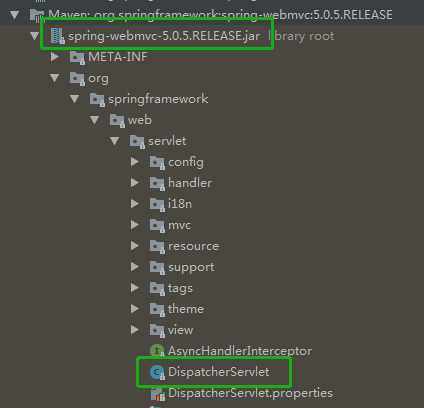
很明显spring-webmvc中存在DispatcherServlet这个类,也就是我们以前SpringMvc的核心Servlet,通过类加载能加载DispatcherServlet这个类,那么我们的应用类型自然就是WebApplicationType.SERVLET
public enum WebApplicationType {
NONE,
SERVLET,
REACTIVE;
private WebApplicationType() {
}
}
设置初始化器(Initializer)
//设置初始化器(Initializer),最后会调用这些初始化器 setInitializers((Collection) getSpringFactoriesInstances( ApplicationContextInitializer.class));
我们先来看看 getSpringFactoriesInstances ( ApplicationContextInitializer.class)
private <T> Collection<T> getSpringFactoriesInstances(Class<T> type) {
return getSpringFactoriesInstances(type, new Class<?>[] {});
}
// 这里的入参type就是ApplicationContextInitializer.class
private <T> Collection<T> getSpringFactoriesInstances(Class<T> type,
Class<?>[] parameterTypes, Object... args) {
ClassLoader classLoader = Thread.currentThread().getContextClassLoader();
// 使用Set保存names来避免重复元素
Set<String> names = new LinkedHashSet<>(
SpringFactoriesLoader.loadFactoryNames(type, classLoader));
// 根据names来进行实例化
List<T> instances = createSpringFactoriesInstances(type, parameterTypes,
classLoader, args, names);
// 对实例进行排序
AnnotationAwareOrderComparator.sort(instances);
return instances;
}
这里面首先会根据入参type读取所有的names(是一个String集合),然后根据这个集合来完成对应的实例化操作:
// 入参就是ApplicationContextInitializer.class
public static List<String> loadFactoryNames(Class<?> factoryClass, ClassLoader classLoader) {
String factoryClassName = factoryClass.getName();
try {
//从类路径的META-INF/spring.factories中加载所有默认的自动配置类
Enumeration<URL> urls = classLoader != null?classLoader.getResources("META-INF/spring.factories"):ClassLoader.getSystemResources("META-INF/spring.factories");
ArrayList result = new ArrayList();
while(urls.hasMoreElements()) {
URL url = (URL)urls.nextElement();
Properties properties = PropertiesLoaderUtils.loadProperties(new UrlResource(url));
//获取ApplicationContextInitializer.class的所有值
String factoryClassNames = properties.getProperty(factoryClassName);
result.addAll(Arrays.asList(StringUtils.commaDelimitedListToStringArray(factoryClassNames)));
}
return result;
} catch (IOException var8) {
throw new IllegalArgumentException("Unable to load [" + factoryClass.getName() + "] factories from location [" + "META-INF/spring.factories" + "]", var8);
}
}
这个方法会尝试从类路径的META-INF/spring.factories处读取相应配置文件,然后进行遍历,读取配置文件中Key为:org.springframework.context.ApplicationContextInitializer的value。以spring-boot-autoconfigure这个包为例,它的META-INF/spring.factories部分定义如下所示:

org.springframework.context.ApplicationContextInitializer=/ org.springframework.boot.autoconfigure.SharedMetadataReaderFactoryContextInitializer,/ org.springframework.boot.autoconfigure.logging.AutoConfigurationReportLoggingInitializer
这两个类名会被读取出来,然后放入到Set<String>集合中,准备开始下面的实例化操作:
// parameterTypes: 上一步得到的names集合
private <T> List<T> createSpringFactoriesInstances(Class<T> type,
Class<?>[] parameterTypes, ClassLoader classLoader, Object[] args,
Set<String> names) {
List<T> instances = new ArrayList<T>(names.size());
for (String name : names) {
try {
Class<?> instanceClass = ClassUtils.forName(name, classLoader);
//确认被加载类是ApplicationContextInitializer的子类
Assert.isAssignable(type, instanceClass);
Constructor<?> constructor = instanceClass.getDeclaredConstructor(parameterTypes);
//反射实例化对象
T instance = (T) BeanUtils.instantiateClass(constructor, args);
//加入List集合中
instances.add(instance);
}
catch (Throwable ex) {
throw new IllegalArgumentException(
"Cannot instantiate " + type + " : " + name, ex);
}
}
return instances;
}
确认被加载的类确实是org.springframework.context.ApplicationContextInitializer的子类,然后就是得到构造器进行初始化,最后放入到实例列表中。
因此,所谓的初始化器就是org.springframework.context.ApplicationContextInitializer的实现类,这个接口是这样定义的:
public interface ApplicationContextInitializer<C extends ConfigurableApplicationContext> {
void initialize(C applicationContext);
}
在Spring上下文被刷新之前进行初始化的操作。典型地比如在Web应用中,注册Property Sources或者是激活Profiles。Property Sources比较好理解,就是配置文件。Profiles是Spring为了在不同环境下(如DEV,TEST,PRODUCTION等),加载不同的配置项而抽象出来的一个实体。
设置监听器(Listener)
下面开始设置监听器:
setListeners((Collection) getSpringFactoriesInstances(ApplicationListener.class));
我们还是跟进代码看看 getSpringFactoriesInstances
// 这里的入参type是:org.springframework.context.ApplicationListener.class
private <T> Collection<? extends T> getSpringFactoriesInstances(Class<T> type) {
return getSpringFactoriesInstances(type, new Class<?>[] {});
}
private <T> Collection<? extends T> getSpringFactoriesInstances(Class<T> type,
Class<?>[] parameterTypes, Object... args) {
ClassLoader classLoader = Thread.currentThread().getContextClassLoader();
// Use names and ensure unique to protect against duplicates
Set<String> names = new LinkedHashSet<String>(
SpringFactoriesLoader.loadFactoryNames(type, classLoader));
List<T> instances = createSpringFactoriesInstances(type, parameterTypes,
classLoader, args, names);
AnnotationAwareOrderComparator.sort(instances);
return instances;
}
可以发现,这个加载相应的类名,然后完成实例化的过程和上面在设置初始化器时如出一辙,同样,还是以spring-boot-autoconfigure这个包中的spring.factories为例,看看相应的Key-Value:
org.springframework.context.ApplicationListener=/ org.springframework.boot.autoconfigure.BackgroundPreinitializer org.springframework.context.ApplicationListener=/ org.springframework.boot.ClearCachesApplicationListener,/ org.springframework.boot.builder.ParentContextCloserApplicationListener,/ org.springframework.boot.context.FileEncodingApplicationListener,/ org.springframework.boot.context.config.AnsiOutputApplicationListener,/ org.springframework.boot.context.config.ConfigFileApplicationListener,/ org.springframework.boot.context.config.DelegatingApplicationListener,/ org.springframework.boot.context.logging.ClasspathLoggingApplicationListener,/ org.springframework.boot.context.logging.LoggingApplicationListener,/ org.springframework.boot.liquibase.LiquibaseServiceLocatorApplicationListener
这10个监听器会贯穿springBoot整个生命周期。至此,对于SpringApplication实例的初始化过程就结束了。
SpringApplication.run方法
完成了SpringApplication实例化,下面开始调用run方法:
public ConfigurableApplicationContext run(String... args) {
// 计时工具
StopWatch stopWatch = new StopWatch();
stopWatch.start();
ConfigurableApplicationContext context = null;
Collection<SpringBootExceptionReporter> exceptionReporters = new ArrayList<>();
configureHeadlessProperty();
// 第一步:获取并启动监听器
SpringApplicationRunListeners listeners = getRunListeners(args);
listeners.starting();
try {
ApplicationArguments applicationArguments = new DefaultApplicationArguments(args);
// 第二步:根据SpringApplicationRunListeners以及参数来准备环境
ConfigurableEnvironment environment = prepareEnvironment(listeners,applicationArguments);
configureIgnoreBeanInfo(environment);
// 准备Banner打印器 - 就是启动Spring Boot的时候打印在console上的ASCII艺术字体
Banner printedBanner = printBanner(environment);
// 第三步:创建Spring容器
context = createApplicationContext();
exceptionReporters = getSpringFactoriesInstances(
SpringBootExceptionReporter.class,
new Class[] { ConfigurableApplicationContext.class }, context);
// 第四步:Spring容器前置处理
prepareContext(context, environment, listeners, applicationArguments,printedBanner);
// 第五步:刷新容器
refreshContext(context);
// 第六步:Spring容器后置处理
afterRefresh(context, applicationArguments);
// 第七步:发出结束执行的事件
listeners.started(context);
// 第八步:执行Runners
this.callRunners(context, applicationArguments);
stopWatch.stop();
// 返回容器
return context;
}
catch (Throwable ex) {
handleRunFailure(context, listeners, exceptionReporters, ex);
throw new IllegalStateException(ex);
}
}
- 第一步:获取并启动监听器
- 第二步:根据SpringApplicationRunListeners以及参数来准备环境
- 第三步:创建Spring容器
- 第四步:Spring容器前置处理
- 第五步:刷新容器
- 第六步:Spring容器后置处理
- 第七步:发出结束执行的事件
- 第八步:执行Runners
下面具体分析。
第一步:获取并启动监听器
获取监听器
跟进 getRunListeners 方法:
private SpringApplicationRunListeners getRunListeners(String[] args) {
Class<?>[] types = new Class<?>[] { SpringApplication.class, String[].class };
return new SpringApplicationRunListeners(logger, getSpringFactoriesInstances(SpringApplicationRunListener.class, types, this, args));
}
这里仍然利用了getSpringFactoriesInstances方法来获取实例,大家可以看看前面的这个方法分析,从META-INF/spring.factories中读取Key为org.springframework.boot. SpringApplicationRunListener 的Values:
org.springframework.boot.SpringApplicationRunListener=/ org.springframework.boot.context.event.EventPublishingRunListener
getSpringFactoriesInstances中反射获取实例时会触发 EventPublishingRunListener 的构造函数,我们来看看 EventPublishingRunListener 的构造函数:
1 public class EventPublishingRunListener implements SpringApplicationRunListener, Ordered {
2 private final SpringApplication application;
3 private final String[] args;
4 //广播器
5 private final SimpleApplicationEventMulticaster initialMulticaster;
6
7 public EventPublishingRunListener(SpringApplication application, String[] args) {
8 this.application = application;
9 this.args = args;
10 this.initialMulticaster = new SimpleApplicationEventMulticaster();
11 Iterator var3 = application.getListeners().iterator();
12
13 while(var3.hasNext()) {
14 ApplicationListener<?> listener = (ApplicationListener)var3.next();
15 //将上面设置到SpringApplication的十一个监听器全部添加到SimpleApplicationEventMulticaster这个广播器中
16 this.initialMulticaster.addApplicationListener(listener);
17 }
18
19 }
20 //略...
21 }
我们看到 EventPublishingRunListener里面有一个广播器,EventPublishingRunListener 的构造方法将SpringApplication的十一个监听器全部添加到SimpleApplicationEventMulticaster这个广播器中, 我们来看看是如何添加到广播器:
1 public abstract class AbstractApplicationEventMulticaster implements ApplicationEventMulticaster, BeanClassLoaderAware, BeanFactoryAware {
2 //广播器的父类中存放保存监听器的内部内
3 private final AbstractApplicationEventMulticaster.ListenerRetriever defaultRetriever = new AbstractApplicationEventMulticaster.ListenerRetriever(false);
4
5 @Override
6 public void addApplicationListener(ApplicationListener<?> listener) {
7 synchronized (this.retrievalMutex) {
8 Object singletonTarget = AopProxyUtils.getSingletonTarget(listener);
9 if (singletonTarget instanceof ApplicationListener) {
10 this.defaultRetriever.applicationListeners.remove(singletonTarget);
11 }
12 //内部类对象
13 this.defaultRetriever.applicationListeners.add(listener);
14 this.retrieverCache.clear();
15 }
16 }
17
18 private class ListenerRetriever {
19 //保存所有的监听器
20 public final Set<ApplicationListener<?>> applicationListeners = new LinkedHashSet();
21 public final Set<String> applicationListenerBeans = new LinkedHashSet();
22 private final boolean preFiltered;
23
24 public ListenerRetriever(boolean preFiltered) {
25 this.preFiltered = preFiltered;
26 }
27
28 public Collection<ApplicationListener<?>> getApplicationListeners() {
29 LinkedList<ApplicationListener<?>> allListeners = new LinkedList();
30 Iterator var2 = this.applicationListeners.iterator();
31
32 while(var2.hasNext()) {
33 ApplicationListener<?> listener = (ApplicationListener)var2.next();
34 allListeners.add(listener);
35 }
36
37 if (!this.applicationListenerBeans.isEmpty()) {
38 BeanFactory beanFactory = AbstractApplicationEventMulticaster.this.getBeanFactory();
39 Iterator var8 = this.applicationListenerBeans.iterator();
40
41 while(var8.hasNext()) {
42 String listenerBeanName = (String)var8.next();
43
44 try {
45 ApplicationListener<?> listenerx = (ApplicationListener)beanFactory.getBean(listenerBeanName, ApplicationListener.class);
46 if (this.preFiltered || !allListeners.contains(listenerx)) {
47 allListeners.add(listenerx);
48 }
49 } catch (NoSuchBeanDefinitionException var6) {
50 ;
51 }
52 }
53 }
54
55 AnnotationAwareOrderComparator.sort(allListeners);
56 return allListeners;
57 }
58 }
59 //略...
60 }
上述方法定义在SimpleApplicationEventMulticaster父类AbstractApplicationEventMulticaster中。关键代码为this.defaultRetriever.applicationListeners.add(listener);,这是一个内部类,用来保存所有的监听器。也就是在这一步,将spring.factories中的监听器传递到SimpleApplicationEventMulticaster中。我们现在知道 EventPublishingRunListener中有一个广播器SimpleApplicationEventMulticaster, SimpleApplicationEventMulticaster广播器中又存放所有的监听器。
启动监听器
我们上面一步通过 getRunListeners 方法获取的监听器为 EventPublishingRunListener,从名字可以看出是启动事件发布监听器,主要用来发布启动事件。
public class EventPublishingRunListener implements SpringApplicationRunListener, Ordered {
private final SpringApplication application;
private final String[] args;
private final SimpleApplicationEventMulticaster initialMulticaster;
我们先来看看 SpringApplicationRunListener这个接口
package org.springframework.boot;
public interface SpringApplicationRunListener {
// 在run()方法开始执行时,该方法就立即被调用,可用于在初始化最早期时做一些工作
void starting();
// 当environment构建完成,ApplicationContext创建之前,该方法被调用
void environmentPrepared(ConfigurableEnvironment environment);
// 当ApplicationContext构建完成时,该方法被调用
void contextPrepared(ConfigurableApplicationContext context);
// 在ApplicationContext完成加载,但没有被刷新前,该方法被调用
void contextLoaded(ConfigurableApplicationContext context);
// 在ApplicationContext刷新并启动后,CommandLineRunners和ApplicationRunner未被调用前,该方法被调用
void started(ConfigurableApplicationContext context);
// 在run()方法执行完成前该方法被调用
void running(ConfigurableApplicationContext context);
// 当应用运行出错时该方法被调用
void failed(ConfigurableApplicationContext context, Throwable exception);
}
SpringApplicationRunListener接口在Spring Boot 启动初始化的过程中各种状态时执行,我们也可以添加自己的监听器,在SpringBoot初始化时监听事件执行自定义逻辑,我们先来看看SpringBoot启动时第一个启动事件listeners.starting():
@Override
public void starting() {
//关键代码,先创建application启动事件`ApplicationStartingEvent`
this.initialMulticaster.multicastEvent(new ApplicationStartingEvent(this.application, this.args));
}
这里先创建了一个启动事件 ApplicationStartingEvent ,我们继续跟进SimpleApplicationEventMulticaster,有个核心方法:
@Override
public void multicastEvent(final ApplicationEvent event, @Nullable ResolvableType eventType) {
ResolvableType type = (eventType != null ? eventType : resolveDefaultEventType(event));
//通过事件类型ApplicationStartingEvent获取对应的监听器
for (final ApplicationListener<?> listener : getApplicationListeners(event, type)) {
//获取线程池,如果为空则同步处理。这里线程池为空,还未没初始化。
Executor executor = getTaskExecutor();
if (executor != null) {
//异步发送事件
executor.execute(() -> invokeListener(listener, event));
}
else {
//同步发送事件
invokeListener(listener, event);
}
}
}
这里会根据事件类型 ApplicationStartingEvent 获取对应的监听器,在容器启动之后执行响应的动作,有如下4种监听器:
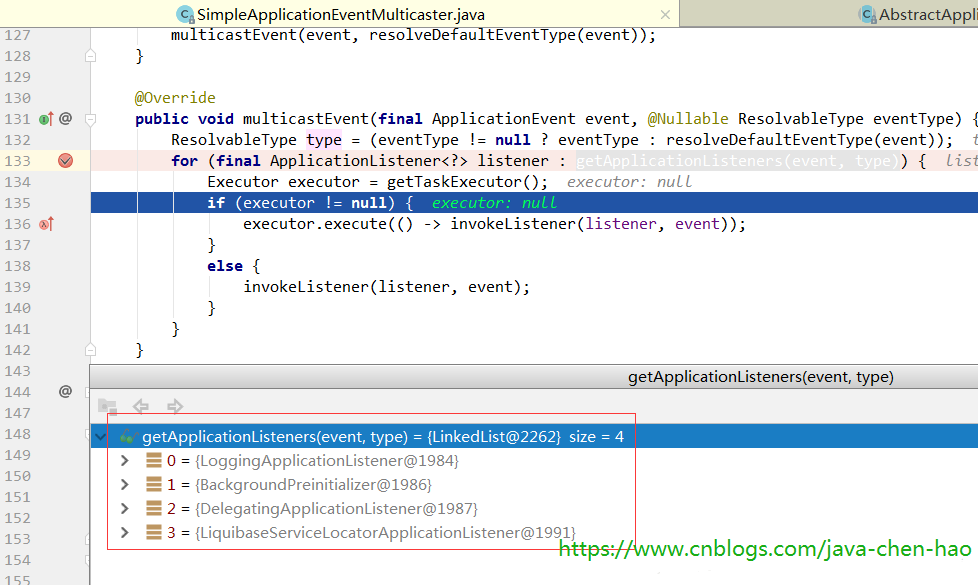
我们选择springBoot 的日志监听器来进行讲解,核心代码如下:
@Override
public void onApplicationEvent(ApplicationEvent event) {
//在springboot启动的时候
if (event instanceof ApplicationStartedEvent) {
onApplicationStartedEvent((ApplicationStartedEvent) event);
}
//springboot的Environment环境准备完成的时候
else if (event instanceof ApplicationEnvironmentPreparedEvent) {
onApplicationEnvironmentPreparedEvent(
(ApplicationEnvironmentPreparedEvent) event);
}
//在springboot容器的环境设置完成以后
else if (event instanceof ApplicationPreparedEvent) {
onApplicationPreparedEvent((ApplicationPreparedEvent) event);
}
//容器关闭的时候
else if (event instanceof ContextClosedEvent && ((ContextClosedEvent) event)
.getApplicationContext().getParent() == null) {
onContextClosedEvent();
}
//容器启动失败的时候
else if (event instanceof ApplicationFailedEvent) {
onApplicationFailedEvent();
}
}
因为我们的事件类型为 ApplicationEvent ,所以会执行 onApplicationStartedEvent((ApplicationStartedEvent) event); 。springBoot会在运行过程中的不同阶段,发送各种事件,来执行对应监听器的对应方法。
第二步:环境构建
ConfigurableEnvironment environment = prepareEnvironment(listeners,applicationArguments);
跟进去该方法:
private ConfigurableEnvironment prepareEnvironment(
SpringApplicationRunListeners listeners,
ApplicationArguments applicationArguments) {
//获取对应的ConfigurableEnvironment
ConfigurableEnvironment environment = getOrCreateEnvironment();
//配置
configureEnvironment(environment, applicationArguments.getSourceArgs());
//发布环境已准备事件,这是第二次发布事件
listeners.environmentPrepared(environment);
bindToSpringApplication(environment);
ConfigurationPropertySources.attach(environment);
return environment;
}
来看一下 getOrCreateEnvironment() 方法,前面已经提到, environment 已经被设置了 servlet 类型,所以这里创建的是环境对象是 StandardServletEnvironment 。
private ConfigurableEnvironment getOrCreateEnvironment() {
if (this.environment != null) {
return this.environment;
}
if (this.webApplicationType == WebApplicationType.SERVLET) {
return new StandardServletEnvironment();
}
return new StandardEnvironment();
}
接下来看一下 listeners.environmentPrepared(environment); ,上面已经提到了,这里是第二次发布事件。什么事件呢?来看一下根据事件类型获取到的监听器:
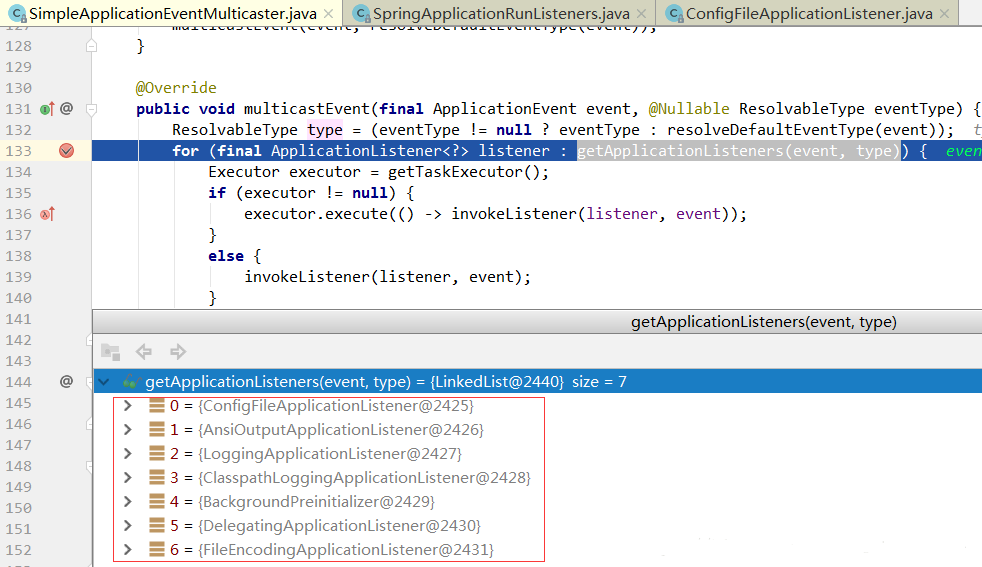
主要来看一下 ConfigFileApplicationListener ,该监听器非常核心,主要用来处理项目配置。项目中的 properties 和yml文件都是其内部类所加载。具体来看一下:
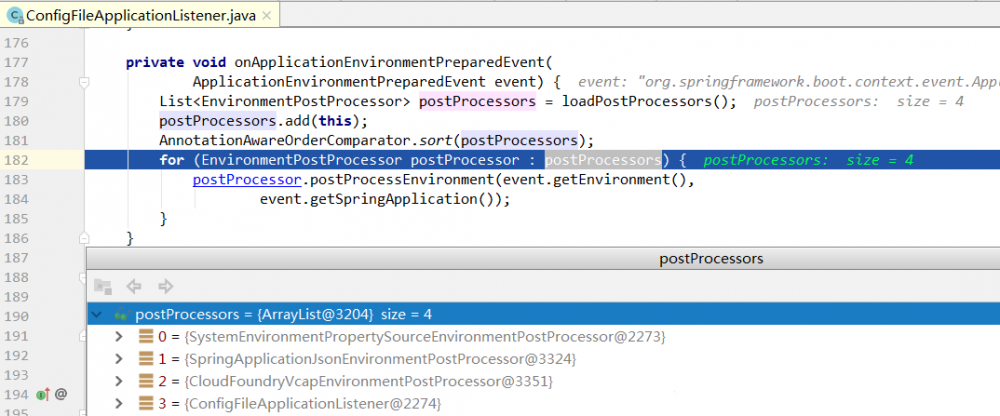
首先还是会去读 spring.factories 文件, List<EnvironmentPostProcessor> postProcessors = loadPostProcessors(); 获取的处理类有以下四种:
# Environment Post Processors org.springframework.boot.env.EnvironmentPostProcessor= org.springframework.boot.cloud.CloudFoundryVcapEnvironmentPostProcessor, org.springframework.boot.env.SpringApplicationJsonEnvironmentPostProcessor, org.springframework.boot.env.SystemEnvironmentPropertySourceEnvironmentPostProcessor
在执行完上述三个监听器流程后, ConfigFileApplicationListener 会执行该类本身的逻辑。由其内部类 Loader 加载项目制定路径下的配置文件:
private static final String DEFAULT_SEARCH_LOCATIONS = "classpath:/,classpath:/config/,file:./,file:./config/";
至此,项目的变量配置已全部加载完毕,来一起看一下:
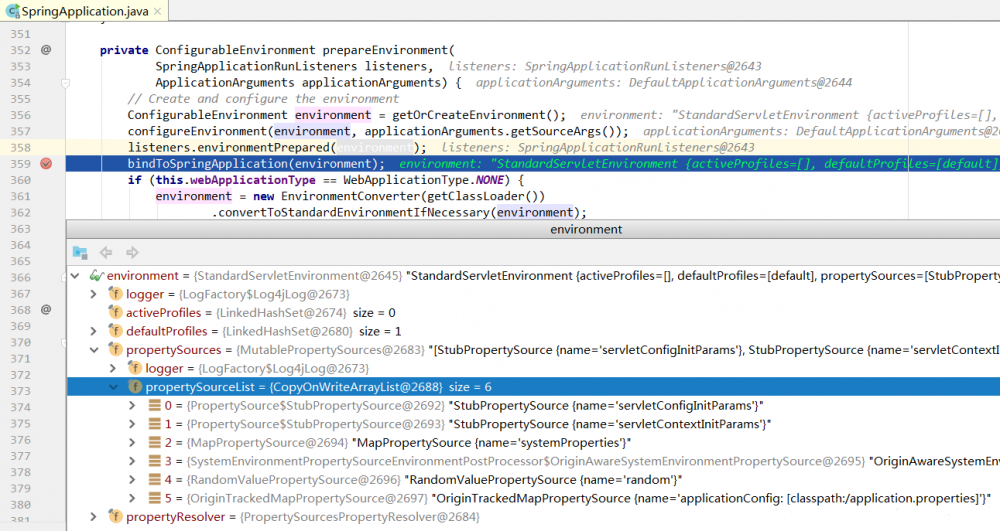
这里一共6个配置文件,取值顺序由上到下。也就是说前面的配置变量会覆盖后面同名的配置变量。项目配置变量的时候需要注意这点。
第三步:创建容器
context = createApplicationContext();
继续跟进该方法:
public static final String DEFAULT_WEB_CONTEXT_CLASS = "org.springframework.boot.web.servlet.context.AnnotationConfigServletWebServerApplicationContext";
protected ConfigurableApplicationContext createApplicationContext() {
Class<?> contextClass = this.applicationContextClass;
if (contextClass == null) {
try {
switch (this.webApplicationType) {
case SERVLET:
contextClass = Class.forName(DEFAULT_WEB_CONTEXT_CLASS);
break;
case REACTIVE:
contextClass = Class.forName(DEFAULT_REACTIVE_WEB_CONTEXT_CLASS);
break;
default:
contextClass = Class.forName(DEFAULT_CONTEXT_CLASS);
}
}
catch (ClassNotFoundException ex) {
throw new IllegalStateException(
"Unable create a default ApplicationContext, "
+ "please specify an ApplicationContextClass",
ex);
}
}
return (ConfigurableApplicationContext) BeanUtils.instantiateClass(contextClass);
}
这里创建容器的类型 还是根据 webApplicationType 进行判断的,该类型为 SERVLET 类型,所以会通过反射装载对应的字节码,也就是 AnnotationConfigServletWebServerApplicationContext
第四步:Spring容器前置处理
这一步主要是在容器刷新之前的准备动作。包含一个非常关键的操作: 将启动类注入容器,为后续开启自动化配置奠定基础。
prepareContext(context, environment, listeners, applicationArguments,printedBanner);
继续跟进该方法:
private void prepareContext(ConfigurableApplicationContext context,
ConfigurableEnvironment environment, SpringApplicationRunListeners listeners,
ApplicationArguments applicationArguments, Banner printedBanner) {
//设置容器环境,包括各种变量
context.setEnvironment(environment);
//执行容器后置处理
postProcessApplicationContext(context);
//执行容器中的ApplicationContextInitializer(包括 spring.factories和自定义的实例)
applyInitializers(context);
//发送容器已经准备好的事件,通知各监听器
listeners.contextPrepared(context);
//注册启动参数bean,这里将容器指定的参数封装成bean,注入容器
context.getBeanFactory().registerSingleton("springApplicationArguments",
applicationArguments);
//设置banner
if (printedBanner != null) {
context.getBeanFactory().registerSingleton("springBootBanner", printedBanner);
}
//获取我们的启动类指定的参数,可以是多个
Set<Object> sources = getAllSources();
Assert.notEmpty(sources, "Sources must not be empty");
//加载我们的启动类,将启动类注入容器
load(context, sources.toArray(new Object[0]));
//发布容器已加载事件。
listeners.contextLoaded(context);
}
调用初始化器
protected void applyInitializers(ConfigurableApplicationContext context) {
// 1. 从SpringApplication类中的initializers集合获取所有的ApplicationContextInitializer
for (ApplicationContextInitializer initializer : getInitializers()) {
// 2. 循环调用ApplicationContextInitializer中的initialize方法
Class<?> requiredType = GenericTypeResolver.resolveTypeArgument(
initializer.getClass(), ApplicationContextInitializer.class);
Assert.isInstanceOf(requiredType, context, "Unable to call initializer.");
initializer.initialize(context);
}
}
这里终于用到了在创建SpringApplication实例时设置的初始化器了,依次对它们进行遍历,并调用initialize方法。我们也可以自定义初始化器,并实现 initialize 方法,然后放入META-INF/spring.factories配置文件中Key为:org.springframework.context.ApplicationContextInitializer的value中,这里我们自定义的初始化器就会被调用,是我们项目初始化的一种方式
加载启动指定类(重点)
大家先回到文章最开始看看,在创建 SpringApplication 实例时,先将 HelloWorldMainApplication.class 存储在this.primarySources属性中,现在就是用到这个属性的时候了,我们来看看 getAllSources()
public Set<Object> getAllSources() {
Set<Object> allSources = new LinkedHashSet();
if (!CollectionUtils.isEmpty(this.primarySources)) {
//获取primarySources属性,也就是之前存储的HelloWorldMainApplication.class
allSources.addAll(this.primarySources);
}
if (!CollectionUtils.isEmpty(this.sources)) {
allSources.addAll(this.sources);
}
return Collections.unmodifiableSet(allSources);
}
很明显,获取了this.primarySources属性,也就是我们的启动类 HelloWorldMainApplication.class, 我们接着看load(context, sources.toArray(new Object[0]));
protected void load(ApplicationContext context, Object[] sources) {
BeanDefinitionLoader loader = createBeanDefinitionLoader(getBeanDefinitionRegistry(context), sources);
if (this.beanNameGenerator != null) {
loader.setBeanNameGenerator(this.beanNameGenerator);
}
if (this.resourceLoader != null) {
loader.setResourceLoader(this.resourceLoader);
}
if (this.environment != null) {
loader.setEnvironment(this.environment);
}
loader.load();
}
private int load(Class<?> source) {
if (isGroovyPresent()
&& GroovyBeanDefinitionSource.class.isAssignableFrom(source)) {
// Any GroovyLoaders added in beans{} DSL can contribute beans here
GroovyBeanDefinitionSource loader = BeanUtils.instantiateClass(source,
GroovyBeanDefinitionSource.class);
load(loader);
}
if (isComponent(source)) {
//以注解的方式,将启动类bean信息存入beanDefinitionMap,也就是将HelloWorldMainApplication.class存入了beanDefinitionMap
this.annotatedReader.register(source);
return 1;
}
return 0;
}
启动类 HelloWorldMainApplication.class 被加载到 beanDefinitionMap中,后续该启动类将作为开启自动化配置的入口,后面一篇文章我会详细的分析,启动类是如何加载,以及自动化配置开启的详细流程。
通知监听器,容器已准备就绪
listeners.contextLoaded(context);
主还是针对一些日志等监听器的响应处理。
第五步:刷新容器
执行到这里,springBoot相关的处理工作已经结束,接下的工作就交给了spring。我们来看看 refreshContext(context);
protected void refresh(ApplicationContext applicationContext) {
Assert.isInstanceOf(AbstractApplicationContext.class, applicationContext);
//调用创建的容器applicationContext中的refresh()方法
((AbstractApplicationContext)applicationContext).refresh();
}
public void refresh() throws BeansException, IllegalStateException {
synchronized (this.startupShutdownMonitor) {
/**
* 刷新上下文环境
*/
prepareRefresh();
/**
* 初始化BeanFactory,解析XML,相当于之前的XmlBeanFactory的操作,
*/
ConfigurableListableBeanFactory beanFactory = obtainFreshBeanFactory();
/**
* 为上下文准备BeanFactory,即对BeanFactory的各种功能进行填充,如常用的注解@Autowired @Qualifier等
* 添加ApplicationContextAwareProcessor处理器
* 在依赖注入忽略实现*Aware的接口,如EnvironmentAware、ApplicationEventPublisherAware等
* 注册依赖,如一个bean的属性中含有ApplicationEventPublisher(beanFactory),则会将beanFactory的实例注入进去
*/
prepareBeanFactory(beanFactory);
try {
/**
* 提供子类覆盖的额外处理,即子类处理自定义的BeanFactoryPostProcess
*/
postProcessBeanFactory(beanFactory);
/**
* 激活各种BeanFactory处理器,包括BeanDefinitionRegistryBeanFactoryPostProcessor和普通的BeanFactoryPostProcessor
* 执行对应的postProcessBeanDefinitionRegistry方法 和 postProcessBeanFactory方法
*/
invokeBeanFactoryPostProcessors(beanFactory);
/**
* 注册拦截Bean创建的Bean处理器,即注册BeanPostProcessor,不是BeanFactoryPostProcessor,注意两者的区别
* 注意,这里仅仅是注册,并不会执行对应的方法,将在bean的实例化时执行对应的方法
*/
registerBeanPostProcessors(beanFactory);
/**
* 初始化上下文中的资源文件,如国际化文件的处理等
*/
initMessageSource();
/**
* 初始化上下文事件广播器,并放入applicatioEventMulticaster,如ApplicationEventPublisher
*/
initApplicationEventMulticaster();
/**
* 给子类扩展初始化其他Bean
*/
onRefresh();
/**
* 在所有bean中查找listener bean,然后注册到广播器中
*/
registerListeners();
/**
* 设置转换器
* 注册一个默认的属性值解析器
* 冻结所有的bean定义,说明注册的bean定义将不能被修改或进一步的处理
* 初始化剩余的非惰性的bean,即初始化非延迟加载的bean
*/
finishBeanFactoryInitialization(beanFactory);
/**
* 通过spring的事件发布机制发布ContextRefreshedEvent事件,以保证对应的监听器做进一步的处理
* 即对那种在spring启动后需要处理的一些类,这些类实现了ApplicationListener<ContextRefreshedEvent>,
* 这里就是要触发这些类的执行(执行onApplicationEvent方法)
* 另外,spring的内置Event有ContextClosedEvent、ContextRefreshedEvent、ContextStartedEvent、ContextStoppedEvent、RequestHandleEvent
* 完成初始化,通知生命周期处理器lifeCycleProcessor刷新过程,同时发出ContextRefreshEvent通知其他人
*/
finishRefresh();
}
finally {
resetCommonCaches();
}
}
}
refresh 方法在spring整个源码体系中举足轻重,是实现 ioc 和 aop的关键。我之前也有文章分析过这个过程,大家可以去看看
第六步:Spring容器后置处理
protected void afterRefresh(ConfigurableApplicationContext context,
ApplicationArguments args) {
}
扩展接口,设计模式中的模板方法,默认为空实现。如果有自定义需求,可以重写该方法。比如打印一些启动结束log,或者一些其它后置处理。
第七步:发出结束执行的事件
public void started(ConfigurableApplicationContext context) {
//这里就是获取的EventPublishingRunListener
Iterator var2 = this.listeners.iterator();
while(var2.hasNext()) {
SpringApplicationRunListener listener = (SpringApplicationRunListener)var2.next();
//执行EventPublishingRunListener的started方法
listener.started(context);
}
}
public void started(ConfigurableApplicationContext context) {
//创建ApplicationStartedEvent事件,并且发布事件
//我们看到是执行的ConfigurableApplicationContext这个容器的publishEvent方法,和前面的starting是不同的
context.publishEvent(new ApplicationStartedEvent(this.application, this.args, context));
}
获取EventPublishingRunListener监听器,并执行其started方法,并且将创建的Spring容器传进去了,创建一个ApplicationStartedEvent事件,并执行ConfigurableApplicationContext 的publishEvent方法,也就是说这里是在Spring容器中发布事件,并不是在SpringApplication中发布事件,和前面的starting是不同的,前面的starting是直接向SpringApplication中的11个监听器发布启动事件。
第八步:执行Runners
我们再来看看最后一步 callRunners (context, applicationArguments);
private void callRunners(ApplicationContext context, ApplicationArguments args) {
List<Object> runners = new ArrayList<Object>();
//获取容器中所有的ApplicationRunner的Bean实例
runners.addAll(context.getBeansOfType(ApplicationRunner.class).values());
//获取容器中所有的CommandLineRunner的Bean实例
runners.addAll(context.getBeansOfType(CommandLineRunner.class).values());
AnnotationAwareOrderComparator.sort(runners);
for (Object runner : new LinkedHashSet<Object>(runners)) {
if (runner instanceof ApplicationRunner) {
//执行ApplicationRunner的run方法
callRunner((ApplicationRunner) runner, args);
}
if (runner instanceof CommandLineRunner) {
//执行CommandLineRunner的run方法
callRunner((CommandLineRunner) runner, args);
}
}
}
如果是ApplicationRunner的话,则执行如下代码:
private void callRunner(ApplicationRunner runner, ApplicationArguments args) {
try {
runner.run(args);
} catch (Exception var4) {
throw new IllegalStateException("Failed to execute ApplicationRunner", var4);
}
}
如果是CommandLineRunner的话,则执行如下代码:
private void callRunner(CommandLineRunner runner, ApplicationArguments args) {
try {
runner.run(args.getSourceArgs());
} catch (Exception var4) {
throw new IllegalStateException("Failed to execute CommandLineRunner", var4);
}
}
我们也可以自定义一些ApplicationRunner或者CommandLineRunner,实现其run方法,并注入到Spring容器中,在SpringBoot启动完成后,会执行所有的runner的run方法
至此,SpringApplication大概分析了一遍,还有很多细节和核心留在下面文章中讲。
- 本文标签: 需求 message 实例 IO web 参数 字节码 servlet map 文章 App Service key id 源码 src Proxy js 代码 监听器 URLs executor java SpringMVC ArrayList pom cat ACE CTO Property XML MQ classpath build 类加载器 https IDE 线程池 遍历 cache spring BeanUtils LinkedList 自动化 线程 生命 CEO BeanDefinition Collections AOP 启动过程 同步 synchronized struct UI Logging 解析 ioc list springboot db tar http HashSet 设计模式 处理器 json Collection ssl final 构造方法 tomcat 配置 Listeners HTML bean value Spring Boot tab ask Qualifier
- 版权声明: 本文为互联网转载文章,出处已在文章中说明(部分除外)。如果侵权,请联系本站长删除,谢谢。
- 本文海报: 生成海报一 生成海报二











![[HBLOG]公众号](https://www.liuhaihua.cn/img/qrcode_gzh.jpg)

